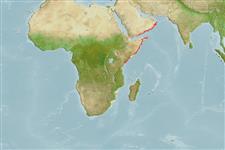>
Ovalentaria/misc (Various families in series Ovalentaria) >
Pseudochromidae (Dottybacks) > Pseudochrominae
Etymology: Pseudochromis: Greek, pseudes = false + Greek, chromis = a fish, perhaps a perch (Ref. 45335).
Environment: milieu / climate zone / depth range / distribution range
पारिस्थितिकी
समुद्री प्रवाल-भित्ति संयुक्त; गहराई सीमा 1 - 8 m (Ref. 11441). Tropical
Western Indian Ocean: Kenya, Oman and Socotra Archipelago.
आकार / वज़न / Age
Maturity: Lm ? range ? - ? cm
Max length : 9.0 cm TL पुल्लिंग / अलिंग; (Ref. 11441)
पृष्ठीय रीढ़ (सम्पूर्ण): 3; पृष्ठीय सौफट रेज़ (सम्पूर्ण): 28-32. This species distinguished by the following characters: 28-32 segmented dorsal-fin rays, all or all but the first 1-2 rays branched; 17-20 segmented anal fin rays; 16-20 circumpeduncular scales; dorsal fin origin to pelvic-fin origin 22.7-27.1% SL; head and body generally brown with darker brown edging on body scale margins and a dark grey to dark blue (dark grey to dark brown when preserved) spot on opercular flap (Ref. 81967).
Life cycle and mating behavior
परिपक्व अवधि | पुनरुत्पत्ति | मछलीऔ का अंडे देना | अंडे | Fecundity | लार्वा
Gill, A.C. and J.K.L. Mee, 1993. Notes on dottyback fishes of the genus Pseudochromis of Oman, with description of a new species (Perciformes: Pseudochromidae). Rev. Fr. Aquariol. 20(2):53-60. (Ref. 12720)
IUCN Red List Status (Ref. 130435)
Threat to humans
Harmless
Human uses
अधिक जानकारी
आम नामउपशब्दचपायचयपरभक्षीईकोटोकसीकोलौजीपुनरुत्पत्तिपरिपक्व अवधिमछलीऔ का अंडे देनाSpawning aggregationFecundityअंडेEgg development
संदर्भजलीयकृषिजलीयकृषि रूपरेखाखींचआनुवंशिकीElectrophoresesहैरेटिबिलटीबीमारीप्रक्रमणNutrientsMass conversion
सहयोगीयोतस्वीरेStamps, Coins Misc.ध्वनिसिगुयटिरारफ्तारतैरने के प्रकारगिल क्षेत्रOtolithsदिमागदृष्टि
साधन
Special reports
Download XML
इंटरनेट स्रोत
Estimates based on models
Preferred temperature (Ref.
123201): 26.2 - 28.5, mean 27.1 °C (based on 288 cells).
Phylogenetic diversity index (Ref.
82804): PD
50 = 0.5000 [Uniqueness, from 0.5 = low to 2.0 = high].
Bayesian length-weight: a=0.01148 (0.00439 - 0.03002), b=3.01 (2.78 - 3.24), in cm total length, based on LWR estimates for this (Sub)family-body shape (Ref.
93245).
Trophic level (Ref.
69278): 3.5 ±0.5 se; based on size and trophs of closest relatives
Fishing Vulnerability (Ref.
59153): Low vulnerability (10 of 100).
